formerly eScholarship Editions


|
|
|
|
Your search for
'Art Theory' in subject
found 20 book(s). | Modify Search | Displaying 1 - 20 of 20 book(s) | |
| 1. | 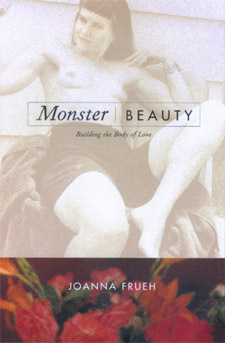 | Title: Monster/beauty: building the body of love Author: Frueh, Joanna Published: University of California Press, 2001 Subjects: Art | Art Theory | Gender Studies | Art Theory | Gender Studies Publisher's Description: This daring, intensely personal book challenges both conventional and feminist ideas about beauty by asking us to take pleasure in beauty without shame, and to see and feel the erotic in everyday life. Bringing together her varied experiences as a poet, art historian, bodybuilder, and noted performance artist, Joanna Frueh shows us how to move beyond society's equation of youth with beauty toward an aesthetic for the fully erotic human being. A lush combination of autobiography, theory, photography, and poetry, this book continues to develop the ideas about the erotic, beauty, older women, sex, and pleasure that Frueh first addressed in Erotic Faculties. Monster/Beauty examines these issues using a provocative, often explicit, set of examples. Frueh admiringly looks at the bodies and mindsets of midlife female bodybuilders, rethinks the vampire, and revises our ideas about traditional models of beauty, such as Aphrodite. Above all, she boldly brings her personal experience into the text, weaving her reflections on female sensuality with contemporary theory. These linked essays are as much a performance as they are a discussion, breaking down the barriers between the personal and the academic, and the erotic and the intellectual. Frueh writes passionately and beautifully, and the result is a much-needed exploration of beauty myths and taboos. [brief] Similar Items |
| 2. | 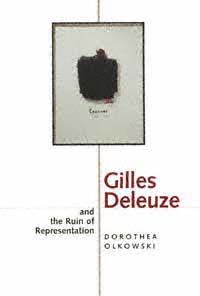 | Title: Gilles Deleuze and the ruin of representation Author: Olkowski, Dorothea Published: University of California Press, 1999 Subjects: Philosophy | Art Theory Publisher's Description: Dorothea Olkowski's exploration of the philosophy of Gilles Deleuze clarifies the gifted French thinker's writings for specialists and nonspecialists alike. Deleuze, she says, accomplished the "ruin of representation," the complete overthrow of hierarchic, organic thought in philosophy, politics, aesthetics, and ethics, as well as in society at large. In Deleuze's philosophy of difference, she discovers the source of a new ontology of change, which in turn opens up the creation of new modes of life and thought, not only in philosophy and feminism but wherever creation is at stake.The work of contemporary artist Mary Kelly has been central to Olkowski's thinking. In Kelly she finds an artist at work whose creative acts are in themselves the ruin of representation as a whole, and the text is illustrated with Kelly's art. This original and provocative account of Deleuze contributes significantly to a critical feminist politics and philosophy, as well as to an understanding of feminist art. [brief] Similar Items |
| 3. | 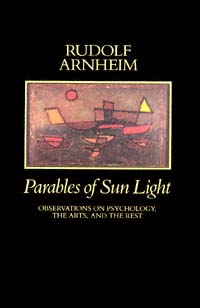 | Title: Parables of sun light: observations on psychology, the arts, and the rest Author: Arnheim, Rudolf Published: University of California Press, 1990 Subjects: Art | Art Theory Publisher's Description: For many years Rudolf Arnheim, known as the leading psychologist of art, has been keeping notebooks in which to jot down observations, ideas, questions, and even (after a stay in Japan for a year) poems in the haiku pattern. Some of these notes found their way into his books - known and prized the world over - such as Art and Visual Perception , Visual Thinking , and The Power of the Center (see list below). Now he has selected, from the remaining riches of his notebooks, the items in this volume. The book will be a joy to ramble through for all lovers of Arnheim's work, and indeed for anyone who shares Arnheim's contagious interest in the order that lies behind art, nature, and human life. It is a seedbed of ideas and observations in his special fields of psychology and the arts. "I have avoided mere images and I have avoided mere thoughts," says Arnheim in the Introduction, "but whenever an episode observed or a striking sentence read yielded a piece of insight I had not met before, I wrote it down and preserved it." There are also glimpses of his personal life - his wife, his cats, his students, his neighbors and colleagues. He is always concrete, in the manner that has become his trademark, often witty, and sometimes a bit wicked.In the blend of life and thought caught in these jottings, psychology and the arts are of course prominent. But philosophy, religion, and the natural sciences add to the medley of topics - always addressed in a way to sharpen the senses of the reader who, sharing Arnheim's cue from Dylan Thomas, may accompany him through "the parables of sun light and the legends of the green chapels and the twice told fields of childhood."All of Rudolf Arnheim's books have been published by the University of California Press. [brief] Similar Items |
| 4. | 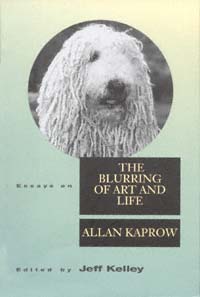 | Title: Essays on the blurring of art and life Author: Kaprow, Allan Published: University of California Press, 1993 Subjects: Art | Art Criticism | Art Theory Publisher's Description: As the creator of "Happenings" and "Environments," Allan Kaprow is the prince and prophet of all we call performance art today. He is also known for having written some of the most thoughtful, provocative, and influential essays of his generation. From "The Legacy of Jackson Pollock" in 1958 to "The Meaning of Life" in 1990, Kaprow has conducted a sustained philosophical inquiry into the paradoxical relationship of art to life, and thus into the nature of meaning itself. With the publication of this book, twenty-three of Kaprow's most significant essays are brought together in one volume for the first time.Kaprow charts his own evolution as an artist and also comments on contemporaneous developments in the arts. From the modernist avant-garde of the fifties to the current postmodern fin de siècle , Kaprow has written about - and from within - the shifting, blurring boundaries of genre, media, culture, and experience. Edited and introduced by critic Jeff Kelley, these essays bring into crisp focus the thinking of one of the most influential figures in the varied landscape of American art since the late 1950s. [brief] Similar Items |
| 5. | 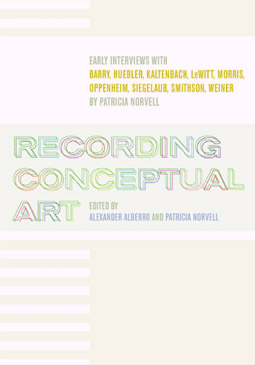 | Title: Recording conceptual art: early interviews with Barry, Huebler, Kaltenbach, LeWitt, Morris, Oppenheim, Siegelaub, Smithson, Weiner, by Patricia Norvell Author: Barry, Robert 1936- Published: University of California Press, 2001 Subjects: Art | Art History | Art Theory Publisher's Description: Recording Conceptual Art features a highly provocative series of previously unpublished interviews conducted in early 1969 with some of the most dynamic, daring, and innovative artists of the tumultuous 1960s. The nine individuals - eight artists and one art dealer - are now known as major contributors to Conceptual art. These fascinating dialogues, conducted by Patricia Norvell, provide tantalizing moments of spontaneous philosophizing and brilliant insights, as well as moments of unabashed self-importance, with highly imaginative and colorful individuals. [brief] Similar Items |
| 6. | 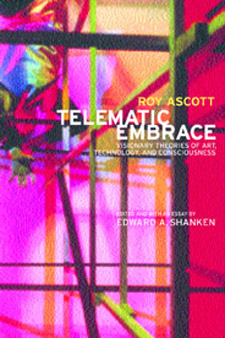 | Title: Telematic embrace: visionary theories of art, technology, and consciousness Author: Ascott, Roy Published: University of California Press, 2003 Subjects: Art | Art Theory | Electronic Media Publisher's Description: Long before e-mail and the Internet permeated society, Roy Ascott, a pioneering British artist and theorist, coined the term "telematic art" to describe the use of online computer networks as an artistic medium. In Telematic Embrace Edward A. Shanken gathers, for the first time, an impressive compilation of more than three decades of Ascott's philosophies on aesthetics, interactivity, and the sense of self and community in the telematic world of cyberspace. This book explores Ascott's ideas on how networked communication has shaped behavior and consciousness within and beyond the realm of what is conventionally defined as art. Telematics, a powerful marriage of computers and telecommunication, made technologies we now take for granted - such as e-mail and automated teller machines (ATMs) - part of our daily life, and made art a more interactive form of expression. Telematic art challenges traditional relationships between artist, artwork, and audience by allowing nonlocal audiences to influence the emergent qualities of the artwork, which consists of the ebb and flow of electronic information. These essays constitute a unique archaeology of ideas, tracing Ascott's meditations on the formation of consciousness through the intertwined cultural histories of art and technology from the 1960s to the present. Shanken's introduction situates Ascott's work within a history of ideas in art, technology, and philosophy. Given the increasing role of the Internet and the World Wide Web in the creation of commerce and community at the dawn of this new millennium, scholars, students, laypeople, policymakers, and artists will find this collection informative and thought-provoking. [brief] Similar Items |
| 7. | 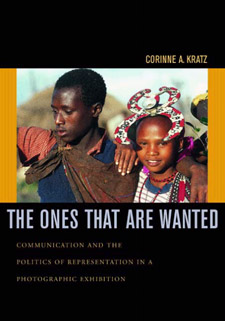 | Title: The ones that are wanted: communication and the politics of representation in a photographic exhibition Author: Kratz, Corinne Ann 1953- Published: University of California Press, 2002 Subjects: Anthropology | Cultural Anthropology | African Studies | Photography | Art Theory Publisher's Description: The Okiek people of Kenya's forested highlands have a long history of hunting, honey gathering, and trading with their Maasai and Kipsigis neighbors; several decades ago, they also began farming and herding. This book follows a traveling exhibition of anthropologist Corinne Kratz's photographs of the Okiek through showings at seven venues, including the National Museum in Nairobi and the Smithsonian Institution in Washington, D.C. Kratz tells the story of the exhibition--the stereotypes it sought to challenge, how commentaries by Okiek people were incorporated, and different ways that viewers in Kenya and the United States understood it. In addition to presenting wonderful images of a little-known people, this inviting book explores the exhibition medium itself, focusing on the complexities and possibilities of cultural representation. Walking a fine line between the photographic intimacy of a family album and the ethnographic distance of documentary photography, The Ones That Are Wanted reproduces the exhibition in full, with its vibrant color photographs, multilingual captions, and lively commentary. Throughout, Kratz incorporates insightful reflections on her changing involvement with the exhibition as anthropologist, photographer, and curator, and she provides perceptive discussions of such topics as photography in Kenya, stereotypes, and the post-1970s proliferation of the politics of representation. [brief] Similar Items |
| 8. | 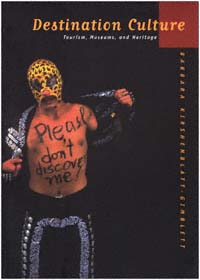 | Title: Destination culture: tourism, museums, and heritage Author: Kirshenblatt-Gimblett, Barbara Published: University of California Press, 1998 Subjects: Art | Art Theory | Popular Culture | Cultural Anthropology | Travel Publisher's Description: Destination Culture takes the reader on an eye-opening journey from ethnological artifacts to kitsch. Posing the question, "What does it mean to show?" Barbara Kirshenblatt-Gimblett explores the agency of display in a variety of settings: museums, festivals, world's fairs, historical re-creations, memorials, and tourist attractions. She talks about how objects - and people - are made to "perform" their meaning for us by the very fact of being collected and exhibited, and about how specific techniques of display, not just the things shown, convey powerful messages. Her engaging analysis shows how museums compete with tourism in the production of "heritage." To make themselves profitable, museums are marketing themselves as tourist attractions. To make locations into destinations, tourism is staging the world as a museum of itself. Both promise to deliver heritage. Although heritage is marketed as something old, she argues that heritage is actually a new mode of cultural production that gives a second life to dying ways of life, economies, and places. The book concludes with a lively commentary on the "good taste/bad taste" debate in the ephemeral "museum of the life world," where everyone is a curator of sorts and the process of converting life into heritage begins. [brief] Similar Items |
| 9. |  | Title: Endless night: cinema and psychoanalysis, parallel histories Author: Bergstrom, Janet 1946- Published: University of California Press, 1999 Subjects: Cinema and Performance Arts | Art Theory | Psychology Publisher's Description: The "endless night" that film theory and psychoanalysis share is the darkness that these two disciplines face in their quest for the logics of intelligibility. This collection emphasizes the history of theory to demonstrate that film theory must be written with a strong sense of historical consciousness, curiosity, and archaeological craft. The volume brings together film theorists and practicing psychoanalysts to encourage an exchange of views between disciplines that encounter each other all too rarely. [brief] Similar Items |
| 10. | 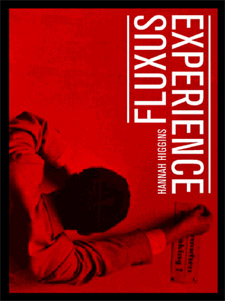 | Title: Fluxus experience Author: Higgins, Hannah 1964- Published: University of California Press, 2002 Subjects: Art | Art History | Art Theory | Art Criticism Publisher's Description: In this groundbreaking work of incisive scholarship and analysis, Hannah Higgins explores the influential art movement Fluxus. Daring, disparate, contentious - Fluxus artists worked with minimal and prosaic materials now familiar in post-World War II art. Higgins describes the experience of Fluxus for viewers, even experiences resembling sensory assaults, as affirming transactions between self and world. Fluxus began in the 1950s with artists from around the world who favored no single style or medium but displayed an inclination to experiment. Two formats are unique to Fluxus: a type of performance art called the Event, and the Fluxkit multiple, a collection of everyday objects or inexpensive printed cards collected in a box that viewers explore privately. Higgins examines these two setups to bring to life the Fluxus experience, how it works, and how and why it's important. She does so by moving out from the art itself in what she describes as a series of concentric circles: to the artists who create Fluxus, to the creative movements related to Fluxus (and critics' and curators' perceptions and reception of them), to the lessons of Fluxus art for pedagogy in general. Although it was commonly associated with political and cultural activism in the 1960s, Fluxus struggled against being pigeonholed in these too-prescriptive and narrow terms. Higgins, the daughter of the Fluxus artists Alison Knowles and Dick Higgins, makes the most of her personal connection to the movement by sharing her firsthand experience, bringing an astounding immediacy to her writing and a palpable commitment to shedding light on what Fluxus is and why it matters. [brief] Similar Items |
| 11. | 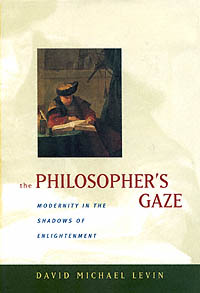 | Title: The philosopher's gaze: modernity in the shadows of enlightenment Author: Levin, David Michael 1939- Published: University of California Press, 1999 Subjects: Philosophy | Gender Studies | Art History | Art Theory Publisher's Description: David Michael Levin's ongoing exploration of the moral character and enlightenment-potential of vision takes a new direction in The Philosopher's Gaze . Levin examines texts by Descartes, Husserl, Wittgenstein, Nietzsche, Heidegger, Benjamin, Merleau-Ponty, and Lévinas, using our culturally dominant mode of perception and the philosophical discourse it has generated as the site for his critical reflections on the moral culture in which we are living.In Levin's view, all these philosophers attempted to understand, one way or another, the distinctive pathologies of the modern age. But every one also attempted to envision - if only through the faintest of traces, traces of mutual recognition, traces of another way of looking and seeing - the prospects for a radically different lifeworld. The world, after all, inevitably reflects back to us the character, the reach and range, of our vision.In these provocative essays, the author draws on the language of hermeneutical phenomenology and at the same time refines phenomenology itself as a method of working with our experience and thinking critically about the culture in which we live. [brief] Similar Items |
| 12. |  | Title: Symbolist art theories: a critical anthology Author: Dorra, Henri 1924- Published: University of California Press, 1995 Subjects: Art | Art History | Art Theory | Art Criticism Publisher's Description: Henri Dorra, in his comprehensive new book, presents the development and the aesthetic theories of the symbolist movement in art and literature. Included are writings (many never before translated or reprinted) by artists, designers, architects, and critics, along with Dorra's learned commentary. Fifty photographs of symbolist works complement his encyclopedic coverage.Dorra traces symbolism and its roots from artist to artist and critic to critic from the 1860s to the early twentieth century. The decorative arts and architecture are examined as well as painting and sculpture. The Arts and Crafts movement, art nouveau, the work of Eiffel in France and Sullivan in the United States are all well represented.The close relations between symbolist poets and artists are reflected in the chapter on literary developments. Baudelaire, Rimbaud, Verlaine, and Mallarmé are here, but so, too, are writers less well-known. A section on the Post-Impressionists and the "Artists of the Soul" rounds out Dorra's rich and varied text, and his epilogue lays the groundwork for what was to follow symbolism.Dorra beautifully integrates the different aesthetic branches of symbolism, the different media and national variations, without ever losing sight of the whole. The historical context provided makes this a particularly appealing collection for students and scholars of art history and literature, as well as for anyone interested in the evolution of symbolism. [brief] Similar Items |
| 13. | 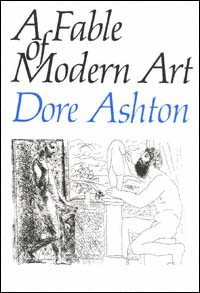 | Title: A fable of modern art Author: Ashton, Dore Published: University of California Press, 1991 Subjects: Art | Art History | Art Theory | Intellectual History Publisher's Description: Dore Ashton's masterly analysis of modern art grows out of a consideration of Balzac's brilliant and little known 'philosophic' story The Unknown Masterpiece in which the concerns of Cézanne, Picasso, and the abstract expressionists are strikingly prefigured. Balzac's fable is discussed not only within the context from which it emerged - early nineteenth-century romanticism - but also in its embodiment of various attitudes towards art. Ashton illuminates a web of associations linking Balzac to Cézanne, Rilke, Schoenberg, Kandinsky and Picasso as they struggle with the yearning to express the inexpressible, to make concrete the abstract.As Professor Ashton develops the conjectures of her book she reveals the interrelations of literature, music, and art and the basic problems which engage or beset the contemporary artist and those who seek to understand and appreciate contemporary art. This is a book of extreme originality which ranges so widely and offers such valuable insights that it forms an important contribution not only to the history of art and culture, but also to the history of ideas. [brief] Similar Items |
| 14. | 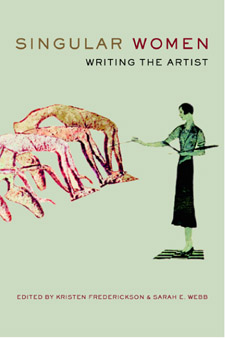 | Title: Singular women: writing the artist Author: Frederickson, Kristen 1965- Published: University of California Press, 2003 Subjects: Art | Art History | Art Criticism | Art Theory | Women's Studies Publisher's Description: In this groundbreaking volume, contemporary art historians - all of them women - probe the dilemmas and complexities of writing about the woman artist, past and present. Singular Women proposes a new feminist investigation of the history of art by considering how a historian's theoretical approach affects the way in which research progresses and stories are told. These thirteen essays on specific artists, from the Renaissance to the present day, address their work and history to examine how each has been inserted into or left out of the history of art. The authors go beyond an analysis of the past to propose new strategies for considering the contributions of women to the visual arts, strategies that take into account the idiosyncratic, personal, and limited rhetoric that confines all writers. [brief] Similar Items |
| 15. | 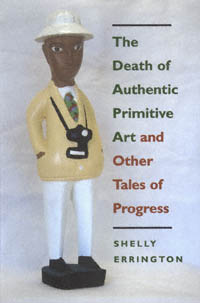 | Title: The death of authentic primitive art and other tales of progress Author: Errington, Shelly 1944- Published: University of California Press, 1998 Subjects: Anthropology | Cultural Anthropology | Art History | Architectural History | Art Theory Publisher's Description: In this lucid, witty, and forceful book, Shelly Errington argues that Primitive Art was invented as a new type of art object at the beginning of the twentieth century but that now, at the century's end, it has died a double but contradictory death. Authenticity and primitivism, both attacked by cultural critics, have died as concepts. At the same time, the penetration of nation-states, the tourist industry, and transnational corporations into regions that formerly produced these artifacts has severely reduced supplies of "primitive art," bringing about a second "death."Errington argues that the construction of the primitive in the nineteenth and twentieth centuries (and the kinds of objects chosen to exemplify it) must be understood as a product of discourses of progress - from the nineteenth-century European narrative of technological progress, to the twentieth-century narrative of modernism, to the late- twentieth-century narrative of the triumph of the free market. In Part One she charts a provocative argument ranging through the worlds of museums, art theorists, mail-order catalogs, boutiques, tourism, and world events, tracing a loosely historical account of the transformations of meanings of primitive art in this century. In Part Two she explores an eclectic collection of public sites in Mexico and Indonesia - a national museum of anthropology, a cultural theme park, an airport, and a ninth-century Buddhist monument (newly refurbished) - to show how the idea of the primitive can be used in the interests of promoting nationalism and economic development.Errington's dissection of discourses about progress and primitivism in the contemporary world is both a lively introduction to anthropological studies of art institutions and a dramatic new contribution to the growing field of cultural studies. [brief] Similar Items |
| 16. | 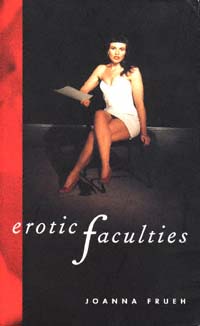 | Title: Erotic faculties Author: Frueh, Joanna Published: University of California Press, 1996 Subjects: Art | Gender Studies | Women's Studies | Literary Theory and Criticism | Art Theory Publisher's Description: The erotic and the intellectual come together to create a new kind of criticism in the lushly written work of Joanna Frueh. Addressing sexuality in ways that are usually hidden or left unsaid, Frueh - a noted performance artist and art historian - explores subjects such as aging, beauty, love, sex, pleasure, contemporary art, and the body as a site and vehicle of knowledge. Frueh's language is explicit, graphic, fragmented. She assumes multiple voices: those of lover, prophet, daughter, mythmaker, art critic, activist, and bleeding heart. What results is an utterly original narrative that frees us from the false objectivity of traditional critical discourse and affirms the erotic as a way to ease human suffering.Through personal reflection, parody, autobiography, and poetry, Frueh shows us what it means to perform criticism, to personalize critical thinking. Rejecting postmodern, deconstructed prose, she recuperates the sentimental, proudly asserts a romantic viewpoint, and disrupts academic and feminist conventions. Erotic Faculties seeks to free the power of our unutilized erotic faculties and to expand the possibilities of criticism; it is a wild ride and a consummate pleasure. [brief] Similar Items |
| 17. | 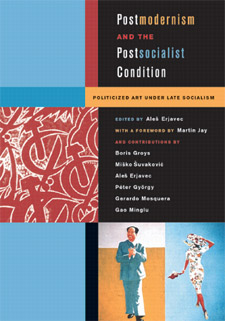 | Title: Postmodernism and the postsocialist condition: politicized art under late socialism Author: Erjavec, Aleš Published: University of California Press, 2003 Subjects: Art | Art History | Art Theory | Intellectual History | Russian and Eastern European Studies Publisher's Description: The Berlin Wall was coming down, the Soviet Union was dissolving, Communist China was well on its way down the capitalist path; the world was witnessing political and social transformations without precedent. Artists, seeing it all firsthand, responded with a revolution of their own. What form this revolution took - how artists in the 1980s marked their societies' traumatic transition from decaying socialism to an insecure future - emerges in this remarkable volume. With in-depth perspectives on art and artists in the former Soviet Union, the Balkans and Mitteleuropa, China, and Cuba - all from scholars and art critics who were players in the tumultuous cultural landscapes they describe - this stunningly illustrated collection captures a singular period in the history of world art, and a critical moment in the cultural and political transition from the last century to our own. Authors Ales Erjavec, Gao Minglu, Boris Groys, Péter György, Gerardo Mosquera, and Misko Suvakovic observe distinct national differences in artistic responses to the social and political challenges of the time. But their essays also reveal a clear pattern in the ways in which artists registered the exhaustion of the socialist vision and absorbed the influence of art movements such as constructivism, pop art, and conceptual art, as well as the provocations of western pop culture. Indebted to but not derived from capitalist postmodernism, the result was a unique version of postsocialist postmodernism, an artistic/political innovation clearly identified and illustrated for the first time in these pages. [brief] Similar Items |
| 18. | 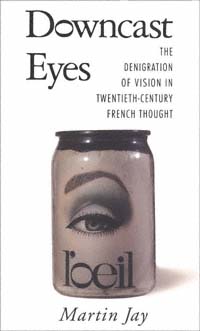 | Title: Downcast eyes: the denigration of vision in twentieth-century French thought Author: Jay, Martin 1944- Published: University of California Press, 1993 Subjects: Philosophy | Intellectual History | French Studies | Literary Theory and Criticism | Art Theory Publisher's Description: Long considered "the noblest of the senses," vision has increasingly come under critical scrutiny by a wide range of thinkers who question its dominance in Western culture. These critics of vision, especially prominent in twentieth-century France, have challenged its allegedly superior capacity to provide access to the world. They have also criticized its supposed complicity with political and social oppression through the promulgation of spectacle and surveillance.Martin Jay turns to this discourse surrounding vision and explores its often contradictory implications in the work of such influential figures as Jean-Paul Sartre, Maurice Merleau-Ponty, Michel Foucault, Jacques Lacan, Louis Althusser, Guy Debord, Luce Irigaray, Emmanuel Levinas, and Jacques Derrida. Jay begins with a discussion of the theory of vision from Plato to Descartes, then considers its role in the French Enlightenment before turning to its status in the culture of modernity. From consideration of French Impressionism to analysis of Georges Bataille and the Surrealists, Roland Barthes's writings on photography, and the film theory of Christian Metz, Jay provides lucid and fair-minded accounts of thinkers and ideas widely known for their difficulty.His book examines the myriad links between the interrogation of vision and the pervasive antihumanist, antimodernist, and counter-enlightenment tenor of much recent French thought. Refusing, however, to defend the dominant visual order, he calls instead for a plurality of "scopic regimes." Certain to generate controversy and discussion throughout the humanities and social sciences, Downcast Eyes will consolidate Jay's reputation as one of today's premier cultural and intellectual historians. [brief] Similar Items |
| 19. | 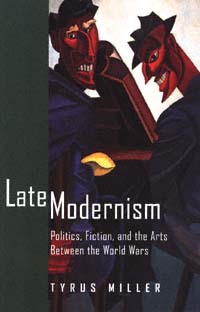 | Title: Late modernism: politics, fiction, and the arts between the world wars Author: Miller, Tyrus 1963- Published: University of California Press, 1999 Subjects: Literature | Fiction | Art Theory | Cinema and Performance Arts | Politics | Political Theory | History Publisher's Description: Tyrus Miller breaks new ground in this study of early twentieth-century literary and artistic culture. Whereas modernism studies have generally concentrated on the vital early phases of the modernist revolt, Miller focuses on the turbulent later years of the 1920s and 1930s, tracking the dissolution of modernism in the interwar years.In the post-World War I reconstruction and the worldwide crisis that followed, Miller argues, new technological media and the social forces of mass politics opened fault lines in individual and collective experience, undermining the cultural bases of the modernist movement. He shows how late modernists attempted to discover ways of occupying this new and often dangerous cultural space. In doing so they laid bare the ruin of the modernist aesthetic at the same time as they transcended its limits.In his wide-ranging theoretical and historical discussion, Miller relates developments in literary culture to tendencies in the visual arts, cultural and political criticism, mass culture, and social history. He excavates Wyndham Lewis's hidden borrowings from Al Jolson's The Jazz Singer ; situates Djuna Barnes between the imagery of haute couture and the intellectualism of Duchamp; uncovers Beckett's affinities with Giacometti's surrealist sculptures and the Bolshevik clowns Bim-Bom; and considers Mina Loy as both visionary writer and designer of decorative lampshades. Miller's lively and engaging readings of culture in this turbulent period reveal its surprising anticipation of our own postmodernity. [brief] Similar Items |
| 20. | 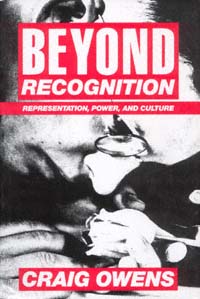 | Title: Beyond recognition: representation, power, and culture Author: Owens, Craig Published: University of California Press, 1992 Subjects: Art | Art Theory | Gender Studies | Sociology | GayLesbian and Bisexual Studies | Art Criticism Similar Items |